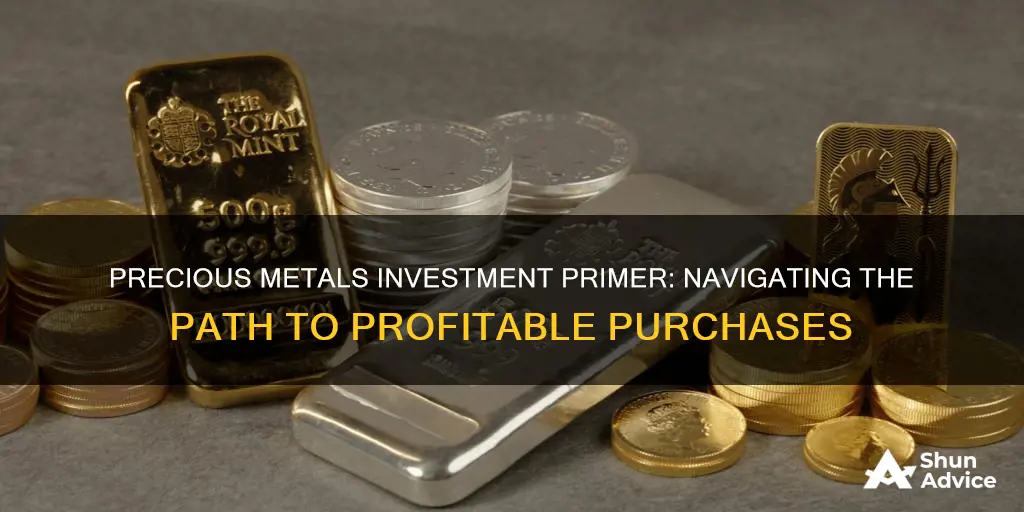
Investing in precious metals is a great way to diversify your portfolio and protect yourself against economic uncertainty. Gold, silver, platinum, and palladium are some of the most common precious metals for investment due to their rarity and high economic value.
There are two main ways to invest in precious metals: buying the physical metal (such as bullion, coins, or jewellery) or investing in exchange-traded funds (ETFs) or mutual funds that focus on precious metals.
Before investing, it's important to understand the different types of precious metals, their various investment strategies, and the market factors influencing their prices. Precious metals prices are influenced by scarcity, availability, natural events, geopolitical activity, market trends, and technological breakthroughs.
Additionally, consider the benefits and drawbacks of investing in precious metals, such as their ability to hedge against inflation and provide portfolio diversification, while also being susceptible to price volatility and having no cash flow.
| Characteristics | Values |
|---|---|
| Purpose | Diversifying an investor's portfolio, hedging against inflation, and protecting against financial or political/military upheaval |
| Forms | Physical metals (coins, bars, jewellery), exchange-traded funds (ETFs), stocks, mutual funds, futures and options, bullion, certificates, mining company stocks |
| Advantages | Intrinsic value, no credit risk, high liquidity, portfolio diversification, protection against inflation |
| Disadvantages | Volatility, storage and insurance costs, theft, high IRS taxes, no cash flow |
| Factors Affecting Price | Supply and demand, economic trends, monetary policies, investor sentiment, natural events, geopolitical activity, market trends, technology breakthroughs |
| Best Practice | Only a portion of the portfolio, with experts suggesting between 5% and 10% |
What You'll Learn

Buying gold, silver, or platinum outright
If you want to buy precious metals outright, you can purchase bullion in the form of coins, bars, or ingots. These can be bought from local currency exchanges or reputable online dealers. The value of bullion varies depending on the type of metal, its age, rarity, and weight.
Before buying, it's important to research how to buy gold and other precious metals to ensure you're purchasing from a reputable dealer. You'll also need to consider the costs of storing and insuring your precious metals, as well as the potential for theft.
Another option for buying outright is to purchase precious metal jewellery. This is a good option if you want to incrementally accumulate wealth over the years.
You can also buy a precious metal IRA, which allows you to own metal without the hassle of storing or transporting it, as it is kept in a bank vault.
Fidelity Investments: A Comprehensive Guide to Buying and Owning Mutual Funds
You may want to see also

Buying an exchange-traded fund (ETF)
Exchange-traded funds (ETFs) are a kind of security where investors pool their money into funds that own financial assets such as stocks, bonds, currencies, futures contracts, and/or commodities like gold bullion. For precious metals ETFs, these funds can include holdings of the physical metals, shares of mining and production companies, or both physical metals and shares of companies.
ETFs are a convenient and liquid means of purchasing and selling gold, silver, palladium, or platinum. They are also extremely liquid, and you can buy or sell them within your brokerage account, allowing for easy portfolio rebalancing and an inexpensive and hassle-free buying/selling process.
The key advantage of ETFs is that they are extremely liquid, and you can buy or sell them within your brokerage account. This allows for easy portfolio rebalancing, and you can buy or sell without the hassle of dealing with physical commodities.
However, ETFs do have some disadvantages. They don't give you access to the physical commodity, so you don't have a claim on the metal in the fund. Additionally, ETFs have expense ratios, which cover security and administrative costs.
- SPDR Gold Trust (GLD)
- IShares Gold Trust (IAU)
- SPDR Gold MiniShares Trust (GLDM)
- Aberdeen Physical Gold Shares ETF (SGOL)
- Sprott Physical Gold Trust (PHYS)
- Perth Mint Physical Gold ETF (AAAU)
- IShares Silver Trust (SLV)
- Aberdeen Physical Silver Shares ETF (SIVR)
- Sprott Physical Silver Trust (PSLV)
The Investment Equilibrium: Unlocking the Balance
You may want to see also

Gold or silver stocks
Gold stocks offer more upside potential than owning physical gold due to their production growth capabilities. Gold stocks are publicly traded investments focused on gold. The industry consists of the following types of entities:
- Mining companies: These companies explore gold resources, develop mines, and sell gold and other metals.
- Gold-focused exchange-traded funds (ETFs): These funds own physical gold or shares of several gold mining companies.
- Gold streaming and royalty companies: These companies pay upfront fees to mining companies in exchange for a percentage of the mine's revenue or the right to purchase future production at a fixed price.
Gold stocks can be good long-term investments. For example, Franco-Nevada, a leading gold-focused royalty and streaming company, has outperformed the price of gold and the broader stock market over the long term. However, not all gold stocks can deliver attractive investment returns due to the risks associated with mining, so investors need to choose carefully.
Silver stocks are also subject to pricing swings and tend to be more volatile than gold stocks. They follow gold's trajectory but in a wilder manner. To mitigate this variability, investors should consider investing in streaming and royalty companies, which provide more stability to a portfolio.
Some examples of gold and silver stocks include:
- Newmont (NYSE: NEM)
- Barrick Gold (NYSE: GOLD)
- Franco-Nevada (NYSE: FNV)
- Royal Gold (NASDAQ: RGLD)
- Sibanye Gold (NYSE: SBGL)
- Sandstorm Gold (NYSEAMERICAN: SAND)
- Hecla Mining (NYSE: HL)
- Wheaton Precious Metals (NYSE: WPM)
- First Majestic Silver (NYSE: AG)
- Pan American Silver (NASDAQ: PAAS)
- Silvercorp Metals (NYSEAMERICAN: SVM)
Unveiling the Secrets to Buying Investment Jewelry
You may want to see also

Bullion
Overall, bullion can be a good investment option for those who want to physically possess their precious metals and are willing to accept the risks and inconveniences associated with storing physical assets.
Understanding Schedule D: Uncovering the Intricacies of Non-Retirement Investments
You may want to see also

Precious metal IRA
A precious metal IRA is a special form of self-directed IRA. This is a type of individual retirement account that allows you to invest in unconventional assets, including precious metals, real estate, and cryptocurrency. Conventional IRAs do not typically allow you to own these types of assets directly.
There are IRS regulations that govern precious metal IRAs, including restrictions on the types of metals you can own and how they are stored. The metals must be kept in a segregated account, separate from other investors' metals. The IRS has set purity standards that must be met: gold must be 99.5% pure, silver must be 99.9% pure, platinum must be 99.95% pure, and palladium must be 99.95% pure.
When investing in a precious metal IRA, it is recommended to do so conservatively. Most experts suggest investing no more than 5-10% of your retirement funds in precious metals. This is because well-designed portfolios are diversified and do not take on unnecessary risks by investing in only one type of asset. Additionally, precious metal IRAs are more expensive than other investment options, with various fees including setup fees, transaction fees, custodial fees, and physical asset storage fees.
To open a precious metal IRA, you will need to select a self-directed IRA custodian, such as a bank or trust company approved by the IRS, and a precious metals dealer. You will then need to choose a depository, which can be recommended by the IRA custodian but must meet the requirements of the Internal Revenue Code. Finally, you will complete the transaction, with the IRA custodian handling payments and the dealer shipping the precious metals to the depository.
Berkshire's Energy Bet: PGE in Focus
You may want to see also
Frequently asked questions
The most common precious metals used for investing are gold, silver, platinum, and palladium.
Precious metals tend to hold their value well due to their scarcity and fixed resources. They can be used in many ways, from industrial applications to jewellery, and they are a tangible asset that can be held in physical form. Additionally, they offer protection against inflation and portfolio diversification.
One of the biggest risks is price volatility, which can be influenced by changes in the economy, Federal Reserve policy, investor demand, mining supply, and inflation. There are also costs associated with storing and insuring physical metals, and they are taxed at a higher rate than capital gains.
There are several ways to invest in precious metals, including purchasing physical bullion, investing in mining company stocks and mutual funds, exchange-traded funds (ETFs), investing in futures, and individual retirement accounts (IRAs).







